Aves in the 10th edition of Systema Naturae
Main article: 10th edition of Systema Naturae
In the 10th edition of Systema Naturae, Carl Linnaeus listed the 564 species of bird from around the world which were known to him at the time.[1] There are now believed to be around 10,000 extant species.[2][3] Linnaeus described the class Aves as:
A beautiful and cheerful portion of created nature consisting of animals having a body covered with feathers and down; protracted and naked jaws (the beak), two wings formed for flight, and two feet. They are areal, vocal, swift and light, and destitute of external ears, lips, teeth, scrotum, womb, bladder, epiglottis, corpus callosum and its arch, and diaphragm.[4]
Linnaean Characteristics [4]
- Heart: 2 auricles, 2 ventricles. Warm, dark red blood
- Lungs: respires alternately
- Jaw: incombent, naked, extended, without teeth
- Eggs: covered with a calcareous shell
- Organs of Sense: tongue, nostrils, eyes, and ears without auricles
- Covering: incumbent, imbricate feathers
- Supports: 2 feet, 2 wings; and a heart-shaped rump. Flies in the Air & Sings
Linnaeus divided the birds based upon the characters of the bill and feet.[5]
Accipitres
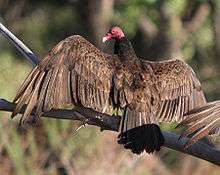
The turkey vulture was named Vultur aura in 1758.
- Vultur gryphus – Andean condor [6]
- Vultur harpyja – harpy eagle [6]
- Vultur papa – king vulture [6]
- Vultur aura – turkey vulture [6][7]
- Vultur barbatus – bearded vulture [8]
- Vultur percnopterus – Egyptian vulture [8]

The swallow-tailed kite was named Falco forficatus in 1758.

The snowy owl was named Strix scandiaca and Strix nyctea in 1758.
- Falco melanaetus – eastern imperial eagle (now Aquila heliaca Savigny, 1809) [9][10]
- Falco chrysaetos & Falco fulvus – golden eagle) [9]
- Falco canadensis – golden eagle (North American subspecies) [7][9]
- Falco rusticolus – gyrfalcon) [9]
- Falco barbarus – [nomen dubium]) [9]
- Falco caerulescens – collared falconet) [9]
- Falco albicilla – white-tailed eagle) [7][11]
- Falco pygargus – Montagu's harrier [11]
- Falco milvus – red kite [11]
- Falco forficatus – swallow-tailed kite [7][11]
- Falco gentilis & Falco palumbarius – northern goshawk [12][11]
- Falco subbuteo – Eurasian hobby [11]
- Falco buteo – common buzzard [13]
- Falco tinnunculus – common kestrel [13]
- Falco cachinnans & Falco sufflator – laughing falcon [14]
- Falco sparverius – American kestrel [7]
- Falco columbarius – merlin
- Falco lanarius – lanner falcon (now Falco biarmicus Temminck, 1825)
- Falco haliaetus – osprey
- Falco gyrfalco – gyrfalcon [15]
- Falco apivorus – European honey buzzard
- Falco aeruginosus – western marsh harrier
- Falco nisus – Eurasian sparrowhawk
- Strix (owls)
- Strix bubo – Eurasian eagle-owl
- Strix scandiaca & Strix nyctea – snowy owl [7]
- Strix asio – eastern screech owl [7]
- Strix otus – long-eared owl
- Strix scops – Eurasian scops-owl
- Strix aluco & Strix stridula – tawny owl
- Strix funerea – Tengmalm's owl
- Strix ulula – northern hawk-owl
- Strix passerina – Eurasian pygmy owl
_RWD.jpg)
The eastern kingbird was named Lanius tyrannus in 1758.
- Lanius (shrikes)
- Lanius cristatus – brown shrike
- Lanius excubitor – great grey shrike
- Lanius collurio – red-backed shrike
- Lanius tyrannus – eastern kingbird [7]
- Lanius carnifex – Guianan red-cotinga
- Lanius schach – long-tailed shrike
- Lanius senator – woodchat shrike
- Lanius caerulescens – white-bellied drongo
- Lanius jocosus – red-whiskered bulbul
- Lanius garrulus – Bohemian waxwing
Picae

The African grey parrot, Psittacus erithacus, is the only species to remain in the genus Psittacus.
- Psittacus (parrots)
- Psittacus macao – scarlet macaw
- Psittacus ararauna – blue-and-yellow macaw
- Psittacus obscurus
- Psittacus nobilis – red-shouldered macaw
- Psittacus severus – chestnut-fronted macaw
- Psittacus borneus – red lory
- Psittacus solstitialis – sun parakeet
- Psittacus carolinensis – Carolina parakeet [7]
- Psittacus alexandri – red-breasted parakeet
- Psittacus pertinax & Psittacus aeruginosus – brown-throated parakeet[16]
- Psittacus canicularis – orange-fronted parakeet
- Psittacus rufirostris
- Psittacus ornatus – ornate lorikeet
- Psittacus agilis – black-billed amazon
- Psittacus cristatus
- Psittacus niger – lesser vasa parrot
- Psittacus sordidus – red-billed parrot
- Psittacus erythroleucus
- Psittacus erithaeus – African gray parrot
- Psittacus garrulus – chattering lory
- Psittacus aurorae
- Psittacus domicella – purple-naped lory
- Psittacus lory – black-capped lory
- Psittacus caerulocephalus
- Psittacus aestivus – blue-fronted amazon
- Psittacus paradisi
- Psittacus festivus – festive amazon
- Psittacus autumnalis – red-lored amazon
- Psittacus accipitrinus – red-fan parrot
- Psittacus melanocephalus – black-headed parrot
- Psittacus collarius – yellow-billed amazon
- Psittacus pullarius – red-headed lovebird
- Psittacus galgulus – blue-crowned hanging parrot
- Psittacus passerinus – green-rumped parrotlet
- Ramphastos piperivorus – [nomen dubium]
- Ramphastos tucanus – white-throated toucan
- Ramphastos picatus – [nomen dubium]
- Ramphastos aracari – black-necked aracari
- Buceros (hornbills)
- Buceros bicornis – great hornbill
- Buceros rhinoceros – rhinoceros hornbill
- Crotophaga (anis)
- Crotophaga ani – smooth-billed ani [7]

The common raven was named Corvus corax in 1758.
- Corvus corax – common raven
- Corvus corone – carrion crow
- Corvus frugilegus – rook
- Corvus cornix – hooded crow
- Corvus benghalensis – Indian roller [18]
- Corvus monedula – jackdaw
- Corvus glandarius – Eurasian jay
- Corvus cristatus – blue jay [7]
- Corvus caryocatactes – spotted nutcracker
- Corvus pica – European magpie
- Corvus paradisi – Asian paradise-flycatcher
- Corvus infaustus – Siberian jay
- Coracias garrulus – European roller
- Coracias caffra
- Coracias oriolus – golden oriole
- Coracias galbula – Baltimore oriole [7]
- Coracias aurea – flame bowerbird
- Coracias xanthornus – black-hooded oriole
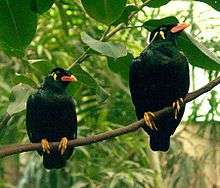
The common hill myna was named Gracula religiosa in 1758.
- Gracula (mynas)
- Gracula religiosa – common hill myna
- Gracula foetida – bare-necked fruitcrow
- Gracula barita – [nomen dubium], possibly Carib grackle [19]
- Gracula cristatella – crested myna [20]
- Gracula saularis – Oriental magpie robin
- Gracula quiscula – common grackle [7]
- Gracula atthis – common kingfisher
- Paradisea (birds-of-paradise)
- Paradisea apoda – greater bird-of-paradise
- Paradisea regia – king bird-of-paradise

The yellow-billed cuckoo was named Cuculus americanus in 1758.
- Cuculus (cuckoos)
- Cuculus canorus – common cuckoo
- Cuculus persa – Guinea turaco
- Cuculus vetula – Jamaican lizard cuckoo
- Cuculus glandarius – great spotted cuckoo
- Cuculus scolopaceus – Asian koel
- Cuculus niger
- Cuculus americanus – yellow-billed cuckoo [7]
- Cuculus auratus – northern flicker
- Jynx (wrynecks)
- Jynx torquilla – Eurasian wryneck
- Picus (woodpeckers)
- Picus martius – black woodpecker
- Picus principalis – ivory-billed woodpecker
- Picus pileatus – pileated woodpecker [7]
- Picus hirundinaceus
- Picus erythrocephalus – red-headed woodpecker [7]
- Picus carolinus – red-bellied woodpecker [7]
- Picus viridis – European green woodpecker
- Picus benghalensis – black-rumped flameback
- Picus semirostris – a "monstrosity" [21]
- Picus major – great spotted woodpecker
- Picus medius – middle spotted woodpecker
- Picus minor – lesser spotted woodpecker
- Picus tridactylus – Eurasian three-toed woodpecker [7]
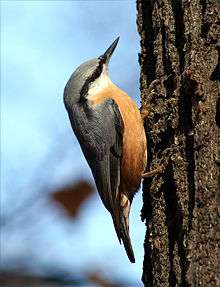
The Eurasian nuthatch was named Sitta europaea in 1758.
- Sitta (nuthatches)
- Sitta europaea – Eurasian nuthatch
- Alcedo (kingfishers)
- Alcedo ispida – subspecies of common kingfisher
- Alcedo erithaca – Oriental dwarf kingfisher
- Alcedo alcyon – belted kingfisher [7]
- Alcedo todus – Jamaican tody
- Alcedo smyrnensis – white-throated kingfisher
- Alcedo rudis – pied kingfisher
- Alcedo dea – paradise jacamar
- Merops (bee-eaters)
- Merops apiaster – European bee-eater
- Merops viridis – blue-throated bee-eater
- Merops cinereus
- Merops cafer – Cape sugarbird
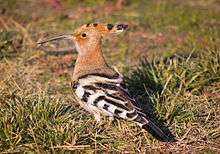
The Hoopoe, Upupa epops, is now the only species in the genus Upupa and the family Upupidae.
- Upupa (hoopoes)
- Upupa epops – Eurasian hoopoe
- Upupa paradisea
- Upupa eremita – northern bald ibis
- Upupa pyrrhocorax – red-billed chough
- Certhia (treecreepers)
- Certhia familiaris – Eurasian treecreeper
- Certhia pusilla
- Certhia caerulea – purple honeycreeper
- Certhia cruentata – scarlet-backed flowerpecker
- Certhia flaveola – bananaquit
.jpg)
The ruby-throated hummingbird was named Trochilus colubris in 1758.
- Trochilus (hummingbirds)
- Trochilus paradiseus
- Trochilus afer
- Trochilus pella – crimson topaz
- Trochilus polytmus – red-billed streamertail
- Trochilus forficatus
- Trochilus colubris – ruby-throated hummingbird [7]
- Trochilus ourissia
- Trochilus mosquitus – ruby-topaz hummingbird
- Trochilus holosericeus – green-throated carib
- Trochilus mellisugus – blue-tailed emerald
- Trochilus tomineo
- Trochilus surinamensis
- Trochilus niger – sooty barbthroat
- Trochilus mellivorus – white-necked jacobin
- Trochilus ruber – reddish hermit
- Trochilus mango – Jamaican mango
- Trochilus cristatus – Antillean crested hummingbird
- Trochilus minimus – vervain hummingbird
Anseres

The king eider was named Anas spectabilis in 1758.
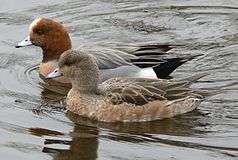
The Eurasian wigeon was named Anas penelope in 1758.
- Anas cygnus – whooper swan
- Anas cygnoides – swan goose
- Anas tadorna – common shelduck
- Anas spectabilis – king eider [7]
- Anas fusca – velvet scoter
- Anas nigra – common scoter
- Anas anser – greylag goose
- Anas erythropus – lesser white-fronted goose [7]
- Anas canadensis – Canada goose [7]
- Anas caerulescens – snow goose
- Anas bernicla – brant goose
- Anas mollissima – common eider
- Anas moschata – Muscovy duck
- Anas bahamensis – white-cheeked pintail
- Anas albeola & Anas rustica – bufflehead [7]
- Anas bucephala – common goldeneye [7]
- Anas clypeata – northern shoveler
- Anas platyrhynchos, Anas boschas & Anas adunca – mallard & domestic duck
- Anas strepera – gadwall
- Anas clangula & Anas glaucion – common goldeneye
- Anas perspicillata – surf scoter [7]
- Anas penelope – Eurasian wigeon
- Anas acuta – northern pintail
- Anas hyemalis – long-tailed duck [7]
- Anas ferina – common pochard
- Anas querquedula & Anas circia – garganey
- Anas crecca – common teal
- Anas histrionica & Anas minuta – harlequin duck [7]
- Anas autumnalis – black-bellied whistling duck
- Anas galericulata – Mandarin duck
- Anas sponsa – wood duck [7]
- Anas arborea – West Indian whistling duck
- Anas fuligula – tufted duck
- Mergus (mergansers)
- Mergus cucullatus – hooded merganser [7]
- Mergus merganser – common merganser
- Mergus serrator – red-breasted merganser
- Mergus albellus & Mergus minutus – smew
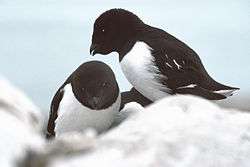
The little auk was named Alca alle in 1758.
- Alca (auks)
- Alca torda – razorbill
- Alca impennis – great auk
- Alca arctica – Atlantic puffin
- Alca lomvia – thick-billed murre
- Alca grylle – black guillemot
- Alca alle – little auk [7]
- Procellaria (petrels)
- Procellaria pelagica – European storm petrel
- Procellaria aequinoctialis – white-chinned petrel
- Procellaria capensis – Cape petrel
.jpg)
The African penguin was named Diomedea demersus in 1758.
- Diomedea (albatrosses & penguins)
- Diomedea exulans – wandering albatross
- Diomedea demersa – African penguin [22]
- Pelecanus (pelicans & kin)
- Pelecanus onocrotalus – great white pelican
- Pelecanus aquilus – Ascension frigatebird
- Pelecanus carbo – great cormorant
- Pelecanus bassanus – northern gannet [7]
- Pelecanus piscator – red-footed booby
- Phaethon (tropicbirds)
- Phaethon aethereus – red-billed tropicbird
- Phaethon demersus

The horned grebe, or Slavonian grebe, was named Colymbus auritus in 1758.
- Colymbus arcticus – black-throated loon [7]
- Colymbus cristatus – great crested grebe
- Colymbus auritus – horned grebe [7]
- Colymbus podiceps – pied-billed grebe
- Larus (gulls)
- Larus tridactylus – black-legged kittiwake
- Larus canus – common gull
- Larus marinus – great black-backed gull
- Larus fuscus – lesser black-backed gull
- Larus atricilla – laughing gull [7]
- Larus parasiticus – parasitic jaeger [7]
- Sterna (terns)
- Sterna stolida – brown noddy [7]
- Sterna hirundo – common tern
- Sterna nigra – black tern
- Rhyncops (skimmers)
- Rhyncops nigra & Rhyncops fulva – black skimmer
Grallae

The American flamingo was named Phoenicopterus ruber in 1758.
- Phoenicopterus (flamingoes)
- Phoenicopterus ruber – American flamingo [7]
- Platalea (spoonbills)
- Platalea leucorodia – Eurasian spoonbill
- Platalea ajaja – roseate spoonbill
- Platalea pygmea – spoon-billed sandpiper
- Mycteria (storks)
- Mycteria americana – wood stork
- Tantalus
- Tantalus loculator – the "wood ibis", a synonym for the wood stork [23]
- Ardea pavonina – black crowned crane
- Ardea virgo – demoiselle crane
- Ardea canadensis – sandhill crane
- Ardea grus – common crane
- Ardea americana – whooping crane
- Ardea antigone – sarus crane
- Ardea ciconia – white stork
- Ardea nigra – black stork
- Ardea nycticorax – black-crowned night heron
- Ardea cinerea – grey heron
- Ardea herodias – great blue heron
- Ardea violacea – yellow-crowned night heron
- Ardea caerulea – little blue heron
- Ardea striata – striated heron
- Ardea virescens – green heron
- Ardea stellaris – Eurasian bittern
- Ardea alba – great egret
- Ardea ibis – cattle egret
- Ardea aequinoctialis
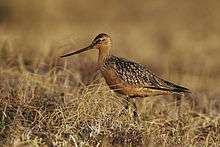
The bar-tailed godwit was named Scolopax lapponica in 1758.
- Scolopax rubra – scarlet ibis
- Scolopax alba & Scolopax fusca – American white ibis [24]
- Scolopax totanus – common redshank
- Scolopax arquata – Eurasian curlew
- Scolopax phaeopus – whimbrel
- Scolopax rusticola – Eurasian woodcock
- Scolopax fedoa – marbled godwit
- Scolopax glottis – common greenshank (now Tringa nebularia) [25]
- Scolopax limosa – black-tailed godwit
- Scolopax gallinago – common snipe
- Scolopax lapponica & Scolopax aegocephala – bar-tailed godwit [26]
- Scolopax haemastica – Hudsonian godwit
- Tringa (phalaropes and sandpipers)

The ruff (shown here in breeding plumage) was named Tringa pugnax in 1758.
- Tringa pugnax – ruff
- Tringa vanellus – northern lapwing
- Tringa gambetta – common redshank [27]
- Tringa interpres – ruddy turnstone
- Tringa lobata – red-necked phalarope
- Tringa fulicaria – red phalarope
- Tringa alpina – dunlin
- Tringa ocrophus – green sandpiper
- Tringa hypoleucos – common sandpiper
- Tringa canutus – red knot
- Tringa glareola – wood sandpiper
- Tringa littorea – common greenshank (now Tringa nebularia) [28]
- Tringa squatarola – grey plover
- Charadrius (plovers)

The European golden plover was named Charadrius apricarius and Charadrius pluvialis in 1758.
- Charadrius cristatus
- Charadrius hiaticula – ringed plover
- Charadrius alexandrinus – Kentish plover
- Charadrius vociferus – killdeer
- Charadrius aegyptius – Egyptian plover
- Charadrius morinellus – Eurasian dotterel
- Charadrius apricarius & Charadrius pluvialis – European golden plover [29]
- Charadrius oedicnemus – Eurasian stone-curlew
- Charadrius himantopus – black-winged stilt
- Charadrius spinosus – spur-winged lapwing
- Recurvirostra (avocets)
- Recurvirostra avosetta – pied avocet
- Haematopus (oystercatchers)
- Haematopus ostralegus – Eurasian oystercatcher
- Fulica (coots & kin)
- Fulica atra – Eurasian coot
- Fulica chloropus – common moorhen
- Fulica porphyrio – purple swamphen
- Fulica spinosa – northern jacana
- Rallus (rails)
- Rallus crex – corn crake
- Rallus aquaticus – water rail
- Rallus lariformis
- Rallus benghalensis – greater painted snipe
- Rallus carolinus – sora
- Psophia (trumpeters)
- Psophia crepitans – grey-winged trumpeter
- Otis (bustards)
- Otis tarda – great bustard
- Otis arabs – Arabian bustard
- Otis tetrax – little bustard
- Otis afra – black bustard
- Struthio (ratites)
- Struthio camelus – ostrich
- Struthio casuarius – southern cassowary
- Struthio americanus – greater rhea
- Struthio cucullatus – dodo
Gallinae
- Pavo (peafowl)
- Pavo cristatus – Indian peafowl
- Pavo bicalcaratus – grey peacock-pheasant
- Meleagris (turkeys)
- Meleagris gallopavo & Meleagris cristata? – wild turkey
- Meleagris satyra – satyr tragopan
- Crax (curassows)
- Crax nigra – black curassow
- Crax rubra – great curassow
- Phasianus gallus – red junglefowl & domesticated chicken
- Phasianus meleagris – helmeted guineafowl
- Phasianus colchicus – common pheasant
- Phasianus pictus – golden pheasant
- Phasianus nycthemerus – silver pheasant
- Tetrao (grouse & kin)
- Tetrao urogallus – western capercaillie
- Tetrao tetrix – black grouse
- Tetrao canadensis – spruce grouse
- Tetrao lagopus – willow ptarmigan
- Tetrao phasianellus – sharp-tailed grouse
- Tetrao cupido – greater prairie chicken
- Tetrao bonasia – hazel grouse
- Tetrao rufus – red-legged partridge
- Tetrao perdix – grey partridge
- Tetrao virginianus & Tetrao marilandicus – northern bobwhite
- Tetrao orientalis – black-bellied sandgrouse
- Tetrao coturnix – common quail
Passeres
- Columba oenas – stock dove
- Columba gutturosa
- Columba cucullata
- Columba turbita
- Columba tremula
- Columba tabellaria
- Columba montana – ruddy quail-dove
- Columba asiatica – white-winged dove
- Columba guinea – speckled pigeon
- Columba hispanica
- Columba palumbus – common wood pigeon
- Columba cyanocephala – blue-headed quail-dove
- Columba leucocephala – white-crowned pigeon
- Columba leucoptera
- Columba nicobarica – Nicobar pigeon
- Columba macroura – mourning dove
- Columba sinica
- Columba indica – emerald dove
- Columba hispida
- Columba turtur – turtle dove
- Columba risoria – Barbary dove
- Columba passerina – common ground dove
- Alauda arvensis – skylark
- Alauda pratensis – meadow pipit
- Alauda arborea – woodlark
- Alauda campestris – tawny pipit
- Alauda trivialis – tree pipit
- Alauda cristata – crested lark
- Alauda spinoletta – water pipit
- Alauda alpestris – shore lark
- Alauda magna – eastern meadowlark
- Sturnus (starlings)
- Sturnus vulgaris – European starling
- Sturnus luteolus
- Sturnus contra – Asian pied starling
- Sturnus cinclus – white-throated dipper
- Turdus (thrushes & kin)
- Turdus viscivorus – mistle thrush
- Turdus pilaris – fieldfare
- Turdus iliacus – redwing [Note 2]
- Turdus musicus – a suppressed name for the song thrush (now Turdus philomelos Brehm, 1831)[Note 2]
- Turdus canorus – Chinese hwamei
- Turdus rufus – brown thrasher
- Turdus polyglottos – northern mockingbird
- Turdus orpheus
- Turdus plumbeus – red-legged thrush
- Turdus crinitus – great crested flycatcher
- Turdus roseus – rosy starling
- Turdus merula – common blackbird
- Turdus torquatus – ring ouzel
- Turdus solitarius – blue rock thrush
- Turdus arundinaceus – great reed warbler
- Turdus virens – yellow-breasted chat
- Loxia (cardinals, bullfinches & kin)
- Loxia curvirostra – common crossbill
- Loxia coccothraustes – hawfinch
- Loxia enucleator – pine grosbeak
- Loxia pyrrhula – Eurasian bullfinch
- Loxia cardinalis – northern cardinal
- Loxia dominicana – red-cowled cardinal
- Loxia cristata
- Loxia mexicana
- Loxia eryocephala – red-headed finch
- Loxia flavicans
- Loxia oryzivora – Java sparrow
- Loxia panicivora
- Loxia punctulata – scaly-breasted munia
- Loxia hordeacea – black-winged red bishop
- Loxia sanguinirostris
- Loxia astrild – common waxbill
- Loxia cyanea
- Loxia lineola – lined seedeater
- Loxia mexicana
- Loxia chloris – European greenfinch
- Loxia butyracea
- Loxia collaria
- Loxia benghalensis – black-breasted weaver
- Loxia malabarica – Indian silverbill
- Loxia fusca
- Loxia melanocephala – black-headed weaver
- Loxia cana
- Loxia nigra – Cuban bullfinch
- Loxia caerulea – blue grosbeak
- Loxia violacea – Greater Antillean bullfinch
- Loxia minuta – ruddy-breasted seedeater
- Loxia bicolor
- Emberiza (buntings)
- Emberiza nivalis – snow bunting
- Emberiza calandra – corn bunting
- Emberiza hortulana – ortolan bunting
- Emberiza citrinella – yellowhammer
- Emberiza orix – southern red bishop
- Emberiza quelea – red-billed quelea
- Emberiza militaris – red-breasted blackbird
- Emberiza atrata
- Emberiza familiaris
- Emberiza flaveola
- Emberiza psittacea
- Emberiza paradisaea – long-tailed paradise whydah
- Emberiza ciris – painted bunting
- Emberiza alario – black-headed canary
- Fringilla (finches & kin)
- Fringilla oryzivora – bobolink
- Fringilla coelebs – common chaffinch
- Fringilla montifringilla- brambling
- Fringilla lulensis
- Fringilla lapponica – Lapland longspur
- Fringilla sylvatica
- Fringilla melancholica
- Fringilla erythrophthalma – eastern towhee
- Fringilla carduelis – European goldfinch
- Fringilla melba – green-winged pytilia
- Fringilla amandava – red munia
- Fringilla gyrola – bay-headed tanager
- Fringilla rubra – summer tanager
- Fringilla tristis – American goldfinch
- Fringilla zena – western spindalis
- Fringilla brasiliana
- Fringilla butyracea
- Fringilla canaria – canary
- Fringilla spinus – Eurasian siskin
- Fringilla flammea – common redpoll
- Fringilla flavirostris – twite
- Fringilla cannabina – linnet
- Fringilla linaria
- Fringilla angolensis – blue-breasted cordon-bleu
- Fringilla violacea – violaceous euphonia
- Fringilla schoeniclus – reed bunting
- Fringilla domestica – house sparrow
- Fringilla montana – Eurasian tree sparrow
- Fringilla chinensis
- Fringilla hyemalis – dark-eyed junco
- Fringilla zena – black-faced grassquit
- Motacilla (wagtails)
- Motacilla luscinia – thrush nightingale
- Motacilla calidris – [nomen dubium] [15]
- Motacilla modularis – dunnock
- Motacilla schoenobaenus – sedge warbler
- Motacilla campestris – orangequit
- Motacilla curruca – lesser whitethroat
- Motacilla hippolais
- Motacilla salicaria
- Motacilla sylvia
- Motacilla philomela
- Motacilla ficedula
- Motacilla alba – white wagtail
- Motacilla flava – yellow wagtail
- Motacilla tiphia – common iora
- Motacilla ruticilla – American redstart
- Motacilla hispanica – black-eared wheatear
- Motacilla oenanthe – northern wheatear
- Motacilla rubetra – whinchat
- Motacilla atricapilla – blackcap
- Motacilla emeria – red-whiskered bulbul
- Motacilla phoenicurus – common redstart
- Motacilla erithacus
- Motacilla titys – female of the common redstart [31]
- Motacilla svecica – bluethroat
- Motacilla sialis – eastern bluebird
- Motacilla velia – opal-rumped tanager
- Motacilla spiza – green honeycreeper
- Motacilla rubecula – European robin
- Motacilla troglodytes – Eurasian wren
- Motacilla regulus – goldcrest
- Motacilla trochilus & Motacilla acredula – willow warbler
- Motacilla pendulinus – European penduline tit
- Motacilla minuta
- Parus cristatus – crested tit
- Parus major – great tit
- Parus americanus – northern parula
- Parus caeruleus – blue tit
- Parus ater – coal tit
- Parus palustris – marsh tit
- Parus caudatus – long-tailed tit
- Parus biarmicus – bearded reedling
- Parus pipra – white-crowned manakin
- Parus erythrocephalus – golden-headed manakin
- Parus aureola – crimson-hooded manakin
- Parus cela – yellow-rumped cacique
- Hirundo rustica – barn swallow
- Hirundo esculenta – glossy swiftlet
- Hirundo urbica – common house martin
- Hirundo riparia – sand martin
- Hirundo apus – common swift
- Hirundo subis – purple martin
- Hirundo pelagica – chimney swift
- Hirundo melba – alpine swift
- Caprimulgus (nightjars)
- Caprimulgus europaeus – European nightjar
- Caprimulgus americanus – Jamaican pauraque
Notes
- ↑ The genus Colymbus was mis-spelt "Columbus" in the list of bird genera on p. 84, but appears as Colymbus elsewhere.
- 1 2 Linnaeus mixed the two species Turdus iliacus and Turdus musicus in the 10th edition of Systema Naturae. Under Turdus iliacus, he gave a description of the song thrush, but cited references referring to the redwing; under Turdus musicus, he gave a description of the redwing, but cited referenced referring to the song thrush. The confusion was partly clarified in the 1766 12th edition. The name Turdus musicus was suppressed after a 1957 appeal to the International Commission on Zoological Nomenclature by Ernst Mayr and Charles Vaurie.[30]
References
- ↑ Ernst Mayr (1946). "The number of species of birds" (PDF). The Auk. 63 (1): 64–69. doi:10.2307/4079907.
- ↑ James F. Clements (2007). The Clements Checklist of Birds of the World (6th ed.). Ithaca, NY: Cornell University Press. ISBN 978-0-8014-4501-9.
- ↑ Frank Gill (2006). Birds of the World: Recommended English Names. Princeton, NJ: Princeton University Press. ISBN 978-0-691-12827-6.
- 1 2 Carl von Linné, translated by William Turton (1802). A general system of nature: through the three grand kingdoms of animals, vegetables, and minerals, systematically divided into their several classes, orders, genera, species, and varieties. Volume 1. London: Lackington, Allen, and Co. p. 131.
- ↑ Sibley & Ahlquist (1990)
- 1 2 3 4 Linnaeus 1758, p. 86.
- 1 2 3 4 5 6 7 8 9 10 11 12 13 14 15 16 17 18 19 20 21 22 23 24 25 26 27 28 29 30 31 32 33 34 35 36 37 38 W. L. McAtee (1957). "The North American birds of Linnaeus". Journal of the Society for the Bibliography of Natural History. 3: 291–300. doi:10.3366/jsbnh.1957.3.Part_5.291.
- 1 2 Linnaeus 1758, p. 87.
- 1 2 3 4 5 6 Linnaeus 1758, p. 88.
- ↑ Chernelházi Chernél István, ed. (1918). Nomenclator Avium Regni Hungariae / A Magyar Birodalom Madarainak Névjegyzéke (PDF) (in Hungarian). Budapest: Officium Regium Hungaricum Ornithologicum / M. Kir. Ornithologiae Központ.
- 1 2 3 4 5 6 Linnaeus 1758, p. 89.
- ↑ "Early Works on Ohio Birds by J. P. Kirtland" (PDF). The Ohio Cardinal. 24 (4): 189–212. 2001. Archived from the original (PDF) on 2011-07-27.
- 1 2 Linnaeus 1758, p. 90.
- ↑ "Laughing Falcon, Herpetotheres cachinnans". World Bird Info. Archived from the original on July 21, 2011. Retrieved October 1, 2010.
- 1 2 Richard C. Banks & M. Ralph Browning (1995). "Comments on the status of revived old names for some North American birds" (PDF). The Auk. 112 (3): 633–648.
- ↑ Stone, Witmer (1913). "On a collection of birds obtained by the Francis E. Bond Expedition in the Orinoco Delta and Paria Peninsula, Venezuela". Proceedings of the Academy of Natural Sciences of Philadelphia. 65: 189-212 [196].
- ↑ James L. Peters (1930). "The identity of the toucans described by Linnaeus in the 10th and 12th editions of the Systema Naturae" (PDF). The Auk. 47 (3): 405–408. JSTOR 4075491.
- ↑ Biswamoy Biswas (1961). "Proposal to designate a neotype for Corvus benghalensis Linnaeus, 1758 (Aves), under the plenary powers Z.N. (S) 1465". Bulletin of Zoological Nomenclature. 18 (3): 217–219.
- ↑ James L. Peters (1921). "A review of the grackles of the genus Holoquiscalus" (PDF). The Auk. 38 (3): 435–453. JSTOR 4073768.
- ↑ "Sturnidae". Check-list of North American Birds (PDF) (7th ed.). American Ornithologists' Union. 1998. pp. 523–524. ISBN 1-891276-00-X.
- ↑ H. E. Strickland; J. S. Henslow; J. Phillips; W. E. Shuckard; J. B. Richardson; G. R. Waterhouse; R. Owen; W. Yarrell; L. Jenyns; C. Darwin; W. J. Broderip; J. O. Westwood (1843). "Series of propositions for rendering the nomenclature of zoology uniform and permanent, being a report of a Committee for the consideration of the subject appointed by the British Association for the Advancement of Science". Annals and Magazine of Natural History. 11: 259–275. doi:10.1080/03745484309445300. Cited in: Alessandro Minelli (2008). "Zoological vs. botanical nomenclature: a forgotten 'BioCode' experiment from the times of the Strickland Code" (PDF). Zootaxa. 1950: 21–38.
- ↑ Denis Lepage. "Jackass Penguin (Spheniscus demersus) (Linnaeus, 1758)". AviBase. Retrieved August 31, 2010.
- ↑ Allen, J.A. (1908). "The generic names Mycteria and Tantalus of Linnaeus, 1758" (PDF). The Auk. 25 (1): 37–38.
- ↑ John Penhallurick. "White Ibis". World Bird Info. Archived from the original on July 24, 2011. Retrieved November 13, 2010.
- ↑ John Penhallurick. "Common Greenshank". World Bird Info. Archived from the original on July 21, 2011. Retrieved November 13, 2010.
- ↑ John Penhallurick. "Bar-tailed Godwit". World Bird Info. Archived from the original on July 21, 2011. Retrieved November 13, 2010.
- ↑ John Penhallurick. "Common Redshank". World Bird Info. Archived from the original on July 24, 2011. Retrieved November 13, 2010.
- ↑ John Penhallurick. "Common Greenshank". World Bird Info. Archived from the original on July 21, 2011. Retrieved November 13, 2010.
- ↑ John Penhallurick. "European Golden-Plover". World Bird Info. Archived from the original on July 24, 2011. Retrieved November 13, 2010.
- ↑ Ernst Mayr & Charles Vaurie (1957). "Proposed use of the plenary powers to suppress the specific name "musicus" Linnaeus, 1758, as published in the combination "Turdus musicus" and to approve a neotype for "Turdus iliacus" Linnaeus, 1758, the Eurasian redwing (class Aves)". Bulletin of Zoological Nomenclature. 13 (6): 177–181.
- ↑ C. E. Hellmayr (1917). "Drei Beiträge zur Nomenklatur der Vögel Europas. Eine kritische Würdigung". Verhandlungen Der Ornithologischen Gesellschaft in Bayern (in German). 13 (1): 87–104.
Sources
- Linnaeus, Carl (1758). Systema Naturæ per regna tria naturae, secundum classes, ordines, genera, species, cum characteribus, differentiis, synonymis, locis (in Latin). Volume 1 (10th ed.). Holmiae (Stockholm): Laurentii Salvii.
This article is issued from Wikipedia - version of the 11/23/2016. The text is available under the Creative Commons Attribution/Share Alike but additional terms may apply for the media files.